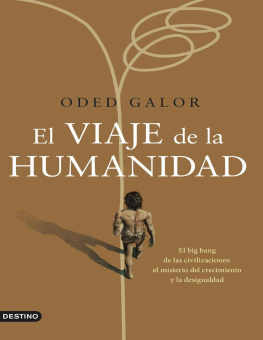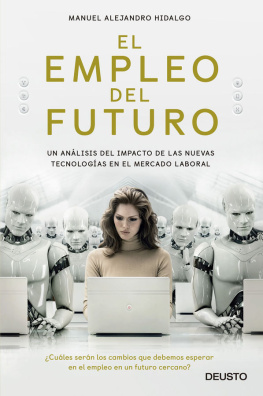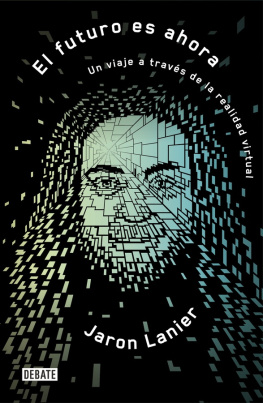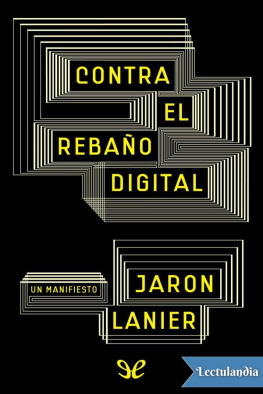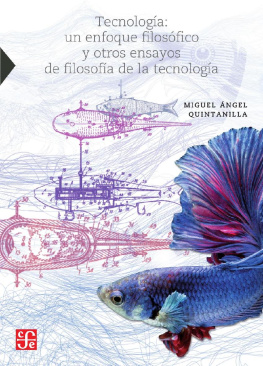. Haidt, Jonathan, “Has Facebook been good for the world?”, Vox , 4 de febrero de 2019.
. Laudato si’ , §105, Verbo Divino, 2015.
. “Facebook labelled digital gangster by report on fake news”, The Guardian , 18 de febrero de 2019.
. The Road to Wigan Pier , Victor Gollancz Ltd., 1937.
. Joy, Bill, “Why the Future Doesn’t Need Us”, Wired , abril de 2000.
. Citado en Bastié, Eugénie, “Michel Desmurget: ‘La exposición precoz a las pantallas es un desastre absoluto’”, Le Figaro , 4 de septiembre de 2019.
. Papa Francisco, Laudato si’ , § 107, op. cit.
. Hunyadi, Mark, La tiranía de los modos de vida , Cátedra, 2015.
. Blay, Michel, Penser ou cliquer , CNRS Éditions, 2016.
. Koenig, Gaspard, La fin du libre arbitre , L’Observatoire, 2019.
. Harari, Yuval Noah, “The myth of freedom”, The Guardian , 14 de septiembre de 2018.
. Harari, Yuval Noah, “Los cerebros hackeados votan”, El País , 6 de enero de 2019.
. Haidt, Jonathan, op. cit.
. Conferencia de diciembre de 1944 publicada en el volumen La France contre les Robots , Le Castor, Astral, 2015.
. “Global mobile consumer survey: US edition”, Deloitte, 2019.
. Según el informe de IDC actualizado el 25 de octubre del 2019.
. Schmidt, Douglas C., “Google Data Collection”, Digital Context Next , 15 de agosto de 2018.
. Citado en Bastié, Eugénie, “Michel Desmurget: ‘L’exposition précoce aux écrans est un désastre absolu’”, Le Figaro , 4 de septiembre del 2019.
. “The Common Sense Census: 2017 Media Use by Kids Age Zero to Eight”, Common Sense, 2017.
. Según Canalys Forecasts, Mobility Services, abril del 2019.
. Roose, Kevin, “Do Not Disturb: How I Ditched My Phone and Unbroke My Brain”, The New York Times , 23 de febrero de 2019.
. Alter, Adam, autor de Irrestible. The Rise of Addictive Technology and the Business of Keeping Us Hooked , Penguin, 2017. Entrevista en El País , 25 de abril de 2018, “La adicción a las pantallas avanza silenciosa”.
. Entrevistado en el programa “L’addiction aux écrans : ‘héroïne numérique’”, Envoyé spécial, France 2, 18 de enero de 2018.
. Davidow, Bill, “Exploiting the Neuroscience of Internet Addiction”, The Atlantic , 18 de diciembre de 2012.
. Data Science Team, “Measuring Product Health”, Sequoia Capital (www.sequoiacap.com/article/measuring-product-health#).
. Declaraciones de noviembre del 2017 en el congreso de Axios, Envoyé Sécial, “Envoyé spécial. L’addiction aux écrans : ‘héroïne numérique’ - 18 janvier 2018 (France 2)”, YouTube, 22 de enero de 2018 (29:20).
. Ibid. (29:50).
. Davidow, Bill, op. cit.
. Price, Catherine, “Putting Down Your Phone May Help You Live Longer”, The New York Times , 24 de abril de 2019.
. Bilton, Nick, “Steve Jobs Was a Low-Tech Parent”, The New York Times , 10 de septiembre de 2014.
. McNamee, Roger, Zucked , Penguin, 2019.
. Véanse, por ejemplo, los estudios del psiquiatra y psicólogo francés Serge Tisseron. Véase también el estudio de Sheri Madigan; Dillon Browne y Nicole Racine, “Association Between Screen Time and Children’s Performance on a Developmental Screening Test”, JAMA Pediatrics , vol. 173, nº 3, 2019, pp. 244–250.
. Informe n° 131 (2018-2019) de Catherine Morin-Desailly, en nombre de la Comisión de Cultura del Senado francés.
. Desmurget, Michel, “La nocivité des écrans pour les enfants est un fait scientifique incontestable”, Le Figaro , 19 de diciembre de 2019.
. Véase la tribuna firmada por los médicos Sylvie Dieu Osika, Eric Osika, Marie-Claude Bossiere, Sabine Duflo, Anne-Lise Ducanda, Bruno Harlé, Lise Barthélémy y Morgane Balland, “Exposition aux écrans: ‘Qui défend-on, les enfants ou l’industrie du numérique?”, 17 de enero de 2019.
. Guimón, Pablo, “Los gurús digitales crían a sus hijos sin pantallas”, El País , 20 de marzo de 2019.
. Corcos, Marilyn y Bergmann, Brigitte, “Le parent hyperconnecté à son portable risque de se déconnecter de son enfant”, Le Monde , 3 de enero de 2020.
. Davidow, Bill, “Exploiting the Neuroscience of Internet Addiction”, The Atlantic , 18 de julio de 2012.
. Le Quyen, Michel, autor de Cerveau et Silence, Flammarion, 2019. Entrevistado por Ferrer, Valérie, “Cerveau et Silence: les liaisons heureuses de la déconnexion”, Le Figaro , 7 de junio de 2019.
, agosto de 2018, pp. 236-244.
. Floridi, Luciano, The Onlife Manifesto. Being Human in a Hyperconnected Era , Springer, 2015.
. Ibid.
. Bochman, Andy, “Internet = insécurité”, Harvard Business Review , edición francesa, abril-mayo de 2019.
. Price, Catherine, op. cit.
. Susarla, Anjarna, “The new digital divide is between people who opt out of algorithms and people who don’t”, The Conversation , 17 de abril de 2019.
. Véase, por ejemplo, Case, Amber, Calm Technology: Principles and Patterns for Non-Intrusive Design , O’Reilly Media, 2015.
. Twenge, Jean M., “Have Smartphones Destroyed a Generation?”, The Atlantic , septiembre de 2017.
. Carr, Nicholas, The Shallows. What the Internet did to our brains , W.W. Norton, 2010.
. Ibid.
. Ibid.
. Véase, por ejemplo, el trabajo de la Universidad de Alberta mencionado en Dugain, Marc y Labbé, Christophe, L’Homme nu. La dictadure invisible du numérique , Plon Editions, 2016, p. 103.
. Wolf, Maryanne, Reader, Come Home: The Reading Brain in a Digital World , Harper Collins, 2018.
. Blay, Michel, op. cit .
. Chotpitayasunondh, Varoth y Douglas, Karen M., “The effects of ‘phubbing’ on social interaction”, Journal of Applied Social Psychology , vol. 48, nº 6, junio de 2018, pp. 304-316.
. The Road to Wigan Pier , Victor Gollancz Ltd, 1937.
. Datos surgidos de un estudio realizado por la empresa de seguridad informática Kapersky en 2015, entre 6.000 personas de más de 16 años en 6 países europeos.
. Según cuentan en su libro My Life Uploaded , Penguin Random House, Londres, 2009.
. Javadi, A.; Emo, B.; Howard, L. et al ., “Hippocampal and prefrontal processing of network topology to simulate the future”, Nature Communications , vol. 8, 14.652, 2017.
. Dugain, Marc y Labbé, Christophe, op. cit .
. “How Technology has Stopped Evolution and is Destroying the World”, The Guardian , 11 de julio de 2013.
. Véase, por ejemplo, Bratsberg, Bernt y Rogeberg, Ole, “Flynn effect and its reversal are both environmentally caused”, PNAS, vol. 115, nº 26, 26 de junio de 2018, pp. 6.674-6.678; publicado por primera vez el 11 de junio de 2018.
, “Requiem for nutrition as the cause of IQ gains: Raven’s gains in Britain 1938–2008”, Economics & Human Biology , 2009.
. Francis Wolff, citado en L’Homme nu , op. cit., p. 178.
. Conferencia en The Artificial Intelligence Channel, “Yuval Harari - The Challenges of The 21st Century”, YouTube, 8 de agosto de 2018.
. L’homme nu, op. cit.
. Plaza López, José Ángel, “Adolescentes hiperconectados: impacientes, indecisos e individualistas”, El País Retina , 14 de febrero de 2019.
. Barrett, Deirdre, Supernormal Stimuli: How Primal Urges Overran Their Evolutionary Purpose , W. W. Norton & Company, 2010.
. Twenge, Jean M., op. cit.
. Véase, por ejemplo, lo que afirma Jonathan Haidt, op. cit.
. Putnam, Robert, “Bowling alone: America’s declining social capital”, Journal of Democracy , vol. 6, nº 1, 1995, pp. 65-78.
. Twenge, Jean M., op. cit. ; iGen: Why Today’s Super-Connected Kids Are Growing Up Less Rebellious, More Tolerant, Less Happy and Completely Unprepared for Adulthood and What That Means for the Rest of Us , Atria Books, 2017.
. Para una opinión que apunta en esta dirección, véase Odger, Candice y Jensen, Michaeline R., “Adolescent mental health in the digital age: facts, fears, and future directions”, The Journal of Child Psychology and Psychiatry , 17 de enero de 2020.




